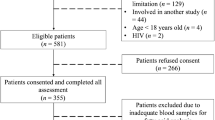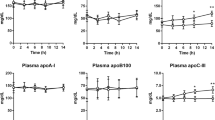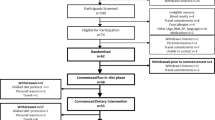Abstract
OBJECTIVES: To examine the hypothesis that a sustained rise in plasma acylation stimulating protein (ASP, C3a desarg) accompanies the elevation in triacylglycerol that follows the ingestion of an oral fat load.
DESIGN: Following an overnight fast, blood samples were obtained from healthy volunteers while fasting and 15 min, 1, 2, 4, 6 and 8 h following ingestion of: (i) a liquid meal, rich in dairy fat (eight subjects) and (ii) a semi-liquid meal, with higher total fat content and rich in polyunsaturated fat (six subjects).
SUBJECTS AND METHODS: Four male and four female volunteers (age range: 22–51 y; body mass index (BMI): 17.9–26.9 kg/m2) received the first meal. Six subjects (age range: 32–60 y; BMI: 18.0–28.4 kg/m2), including three from the first study, received the second meal using the same protocol. ASP and C5a were measured by radioimmunoassay (RIA) and the complement proteins C3, factor B and C5 by radial immunodiffusion or nephelometry. Tumour necrosis factor (TNF)-α was measured by enhanced ELISA, and plasma cholesterol and triacylglycerol by an automated enzymatic method. The presence of chylomicrons was assessed in post-prandial plasma samples taken after the second meal.
RESULTS: There was no significant change in mean ASP concentration in either group at any time point, following ingestion of either meal. However, there was a significant positive linear trend in ASP following the second fat challenge (ANOVA; P<0.05). There was also no change in complement proteins, plasma cholesterol or TNF-α. Plasma triacylglycerol rose significantly after the first and second meals (P<0.05 and P<0.001 at 2 h post-prandially); the mean maximum rise above the fasting level was 58±41% and 89±38% respectively (mean±s.d.). Chylomicrons were detected in samples taken from each subject after the second meal. Analysis of individual ASP data showed a sustained rise in one subject after the first meal and two subjects after the second meal. Substantial variation in ASP concentration was observed in samples taken in the first 2 h post-prandially.
CONCLUSION: There was no significant change in ASP nor other complement proteins for either group of subjects following ingestion of the lipid loads. Individual data showed substantial variation in post-prandial ASP, but multiple plasma sampling did not define the basis for this variation.
This is a preview of subscription content, access via your institution
Access options
Subscribe to this journal
Receive 12 print issues and online access
$259.00 per year
only $21.58 per issue
Buy this article
- Purchase on Springer Link
- Instant access to full article PDF
Prices may be subject to local taxes which are calculated during checkout
Similar content being viewed by others
Author information
Authors and Affiliations
Rights and permissions
About this article
Cite this article
Charlesworth, J., Peake, P., Campbell, L. et al. The influence of oral lipid loads on acylation stimulating protein (ASP) in healthy volunteers. Int J Obes 22, 1096–1102 (1998). https://doi.org/10.1038/sj.ijo.0800733
Received:
Revised:
Accepted:
Published:
Issue Date:
DOI: https://doi.org/10.1038/sj.ijo.0800733
Keywords
This article is cited by
-
Influence of acute hyperlipidemia to adipocyte-derived hormones in lean normotensive and subjects with metabolic syndrome
Diabetology & Metabolic Syndrome (2014)
-
Relationships among acylation stimulating protein, adiponectin and complement C3 in lean vs obese type 2 diabetes
International Journal of Obesity (2006)
-
Response of the alternative complement pathway to an oral fat load in first-degree relatives of subjects with type II diabetes
International Journal of Obesity (2005)
-
Weight gain in relation to plasma levels of complement factor 3: results from a population-based cohort study
Diabetologia (2005)
-
Acylation stimulating protein (ASP) acute effects on postprandial lipemia and food intake in rodents
International Journal of Obesity (2001)



